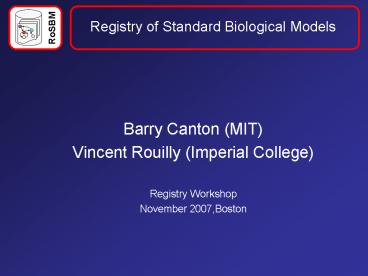Registry of Standard Biological Models - PowerPoint PPT Presentation
Title:
Registry of Standard Biological Models
Description:
Michigan iGEM Team 07. RoSBM. Challenges. Modeling takes time, expertize ... Data Connectivity. Parts. Models. Exp.Data. Sim.Data. Parts. Parts. Exp.Data ... – PowerPoint PPT presentation
Number of Views:32
Avg rating:3.0/5.0
Title: Registry of Standard Biological Models
1
Registry of Standard Biological Models
- Barry Canton (MIT)
- Vincent Rouilly (Imperial College)
- Registry Workshop
- November 2007,Boston
2
Biological Systems Need Models!
Michigan iGEM Team 07
3
Challenges
- Modeling takes time, expertize
- Weak adoption of standards for model construction
- Models hard to share, reuse
(Sound familiar?)
4
Challenges
- Building takes time, expertize
- Weak adoption of standards for system
construction - Parts hard to share, reuse
5
Registry of Standard Biological Parts
http//parts.mit.edu
6
Registry of Standard Biological Models
http//openwetare.org/wiki/RoSBM
7
Modeling the Parts Registry
Parts
Project 5 -models-
Project 1 -models-
Project 2 -models-
Project 3 -models-
Project 4 -models-
8
Modeling with Parts Models Registries
Project 5 -models-
Project 1 -models-
Project 2 -models-
Project 3 -models-
Project 4 -models-
9
Open data sharing
Model Predictions
Experimental Data
Project 5 -models-
Project 1 -models-
Project 2 -models-
Project 3 -models-
Project 4 -models-
10
CellML Database
http//www.cellml.org/models
11
Biomodels Database
http//www.ebi.ac.uk/biomodels/
12
Asmparts software
http//soft.synth-bio.org/asmparts.html
13
MIRIAM initiative
14
RoSBM Motivations / Mission
- to gain a deeper understanding of the function of
BioBricks. - to promote the re-usability of BioBrick models.
- to explore through simulations the properties of
de-novo assemblies of parts. - to progress towards a faster/cheaper development
process. - to complement the open-source spirit of Synthetic
Biology and open-up a new form of in Silico
contributions.
15
What Do We Want the RoSBM to Do?
- Store, Search, Annotate, and Curate models of
standardized biological parts. - Provide a one-to-many match between DNA
biological parts and models. - Interface with CAD tools.
16
BioBrick Characterization
17
BioBrick Characterization
Experiments
Modeling
Early experiments to estimate dynamic range of
AHL and general response
Define Model
Fit Model on Data
More experiments to improve estimation Of
parameters
Predict next best experimental points
Fit model on new data
18
One part, many models?
GFP(t) f(AHL,LuxR,t)
BBa_T9002
GFP f(AHL)
GFP(t) f(AHL,mRNALuxR, PLuxR, mRNAGFP, PLuxR,
RNAp, Ribosomes, t)
19
(No Transcript)
20
Proof of Concept
21
desired relationships
Part category
Model category
Models Including This one
Bio DB
Part
Model
Similar Models
Models Included in this one
22
Data Connectivity
23
Data Connectivity
24
Data Connectivity
25
Data Connectivity
26
Thank you!
bcanton_at_mit.edu vincent.rouilly_at_gmail.com http//o
penwetware.org/wiki/RoSBM
27
ideas
- Level of abstraction
- controlled vocabularies
- Description language
- MIAGE standard
28
Model Curation
- Machine readable
- Conform to a description standard
- Make sure the model works
- Referencing author, publications, contact
- Pointing to biological databases
- MIRIAM standard
29
SBML / CellML Overview
Compartments
Species
SBML model
Rules
Reactions
Events
Components
CellML model
Variables name, init_value, interface, units
Math
Units
Imports
30
What is a Biological Part Model?
- What we mean by Biological Model
- Abstraction of a biological process using a
formal mathematical description - Focus on kinetic models
- Focus on Ordinary Differential Equations System
31
Content
- Advantages offered by modelling
- Problems to be addressed
- A solution to some of the above (Motivations)
- An example of a model entry in the RoSBM
(Scenarii of use) - What is a Standard Biological Model ?
- Simple Model repository or reusable modeling
component. - Open issues (level of abstraction, description
language, )
32
Current Practices
- More and more projects explore their project with
modelling - Matlab, C/C, Proprietary platform, SBML
33
Unused Images































